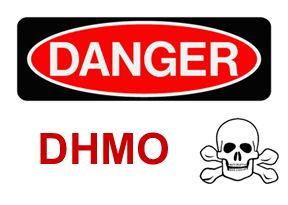 I want to tell you a riddle today, about DHMO.
I want to tell you a riddle today, about DHMO.
It causes death if you accidentally inhale it, even in small quantities. Prolonged exposure to solid DHMO causes severe tissue damage. It’s a major component of acid rain. In a gas form, it can cause severe burns. It contributes to soil erosion…
It’s sometimes called Dihydrogen Monoxide. But it’s also known as… H20! 🙂
There’s a whole website created about DHMO (http://www.dhmo.org/facts.html ), written by a college professor who wanted his students to learn to think critically about what they read, and not just take things at face value.
School librarians around the US use this website to “trick” their students into doing research about this compound, only to watch their eyes open wide when they realize it’s just water! When this happens, the students are at first pleased with themselves for figuring it out, and then a little sheepish, as they realize how gullible they often are.
This lesson is just as relevant when you’re reading information about health and fitness.
You have to read everything with a critical eye, asking yourself, “Does this make sense? Where did they get their information? Who ran the studies behind this idea? Are they reputable?”
Just like students are learning to read and think critically in their school libraries, adults – many of whom didn’t grow up with the internet at their fingertips, who aren’t used to the flood of information currently available – must also read carefully and consider the source!
Every new “fad diet” that comes out may be based on proven scientific information… or it may simply be based on some new theory that a charismatic leader has decided to push out to the public as a way to make money.
Besides, some diets are right for some people, and other diets are right for other people. So deciding if something is not only accurate and research-based, but also relevant to YOU, is critical.
One place where you really have to read carefully is the grocery store. All those food labels can be pretty misleading!
For instance, if it says, “made with whole grains”, you may think it’s ALL whole grains, when in actuality, it might be just a pinch! It may also say, “multi-grain”, and you think it’s literally that: made with a variety of grains. But it could simply be a variety of refined grains.
If it says, “no cholesterol”, you think it’s specially formulated for a healthier version. The truth is, only animal products ever have cholesterol in them! So “cholesterol-free tomato sauce” is misleading; it never had cholesterol in the first place.
If it says, “natural” it means… nothing. No official organization verifies this claim.
I also caution you about what is NOT listed: sugar. No company wants to list sugar as a top ingredient, even if it is. So they list the various FORMS of sugar, which allows them to show up later in the list (the lists are always arranged so the ingredients with the highest percentage are listed first). Look for high fructose corn syrup, cane juice, fruit juice concentrates, isomalt, maltodextrin, inversol, hexitol, malt syrup… There are lots of them!
Because it can be so tricky to understand both labels, and what the latest fad trends are, I encourage you to get professional advice. I’ve spent years in the health industry, and I make it my business to stay on top of all the most recent – and relevant – scientific studies about what works, and for whom it works best.
I know you don’t have time to sort it all out; that’s my job! And I’d love to be able to help you figure out what works best for you.
If you’re ready to sort through all the tricks and noise out there, so you can get healthy and fit faster, I invite you to sign up for a time for us to chat and get to know each other. I’ll give you my honest opinion about what health and fitness plans are best for you. Reach out to schedule a free 30-minute chat with me.



Leave a Reply